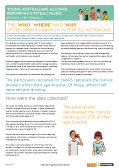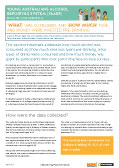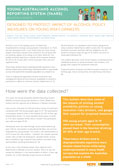YAARS Bulletins
2016-17 Bulletins
These four-page bulletins provide a graph-based overview of each state and territory’s ‘most recent risky drinking session’ 2016-17 findings.
2013 Bulletins
The Young Australians Alcohol Reporting System (YAARS) is a university research project looking at trends in alcohol use amongst young people across Australia. We surveyed 958 participants in Perth, Melbourne, Bunbury (regional WA), and Sydney. These 16-19 year olds were selected to represent the riskiest drinking 20-25% of their age bracket. The information from this study will be used to make recommendations on how to make things safer for young people.
YAARS is a collaboration between the National Drug Research Institute (NDRI, Curtin University), the National Drug and Alcohol Research Centre (NDARC, University of New South Wales), Turning Point (Monash University) and St John of God Hospital (Bunbury).
 Bulletin 1: The 'who' 'where' and 'why' of pre-drinking among young 16-19 year old Australians
Bulletin 1: The 'who' 'where' and 'why' of pre-drinking among young 16-19 year old Australians
Pre-drinking, also known as having 'pre's' or 'pre-loading', is consuming alcohol before going out to another venue.
Bulletin 1 in this series focuses on who was pre-drinking, where they chose to pre-drink, and why participants were pre-drinking.
Forty-three percent of the face-to-face participants reported that last time they were pre-drinking they consumed 7+ drinks.
Pre-drinking was more commonly reported by the 18-19 year old compared to the 16-17 year old participants and most commonly occurred at the house of a a friend or acquaintance.
The main reasons for pre-drinking were price, to catch up with friends, to get intoxicated and to have fun.
Reference list for Bulletin 1.
 Bulletin 2: 'What' was consumed, and 'how much' time and money were invested pre-drinking
Bulletin 2: 'What' was consumed, and 'how much' time and money were invested pre-drinking
Pre-drinking, also known as having 'pre's' or 'pre-loading', is consuming alcohol before going out to another venue.
This second bulletin addresses how much alcohol and time was spent pre-drinking, what types of drinks were consumed, and how much money was spent by participants.
The mean quantity consumed while pre-drinking was 6.54 standard drinks, with responses ranging from 1-20 standard drinks. The amount of alcohol consumed exceeds the current national guidelines for single occasion risky drinking.
The most common drinks consumed as pre-drinks were spirits, beer and wine, and the average amount of money spent on pre-drinks was $24.
The older male and female demographics were more likely to nominate price and they liked the taste as reasons for pre-drinking.
Bulletins 1 & 2 are based on the following journal article: Ogeil R P, Lloyd B, Lam T, Lenton S, Burns L, Aiken A, Gilmore W, Chikritzhs T, Mattick R, Allsop S, Lubman D (2016) Pre-drinking behaviour of young heavy drinkers. Substance Use and Misuse. doi: 10.3109/10826084.2016.1168443
Reference list for Bulletin 2.
 Bulletin 3: Designed to protect: impact of alcohol policy measures on young risky drinkers
Bulletin 3: Designed to protect: impact of alcohol policy measures on young risky drinkers
This bulletin describes some of the impacts of existing alcohol availability policies on young Australian risky drinkers, and gauges their support for proposed measures.
This study found that age-based restrictions on alcohol are commonly circumvented by young risky drinkers. Of the 16-17 year olds who had previously attempted to enter a licensed venue, the majority (51%) reported they did not have their ID checked the last time they attempted entry. The last time they tried, almost half (49%) of participants aged under 18 rated it as easy or very easy for them to purchase alcohol from the bottle shop.
A large body of past research indicates that price consistently has an impact on consumption. This survey found support for an increase in price even among one of the populations at greatest risk of alcohol related harm. Two-thirds (65%) of the risky drinking young people supported increasing the price of a standard drink by 20¢ if the extra 20¢ was used to support prevention and treatment of alcohol problems. Similarly modest taxes have previously been found to reduce alcohol related mortality. Young Australians appear to support price-based alcohol taxation measures so long as the extra funds were earmarked for prevention and treatment of alcohol-related problems.
Bulletin 3 is based on the following journal article: Lam T, Lenton S, Burns L, Aiken A, Ogeil R, Gilmore W, Chikritzhs T, Lloyd B, Lubman D, Mattick R, Allsop S. (2015; 39). 'Alcohol policy impact on young risky drinkers and their support for proposed measures'. Australian & New Zealand Journal of Public Health. doi: 10.1111/1753-6405.12326.
Reference list for Bulletin 3.
Funding
This project was supported by the Australian National Preventative Health Agency. NDRI and NDARC are supported by funding from the Australian Government under the Substance Misuse Prevention and Service Improvement Grants Fund.